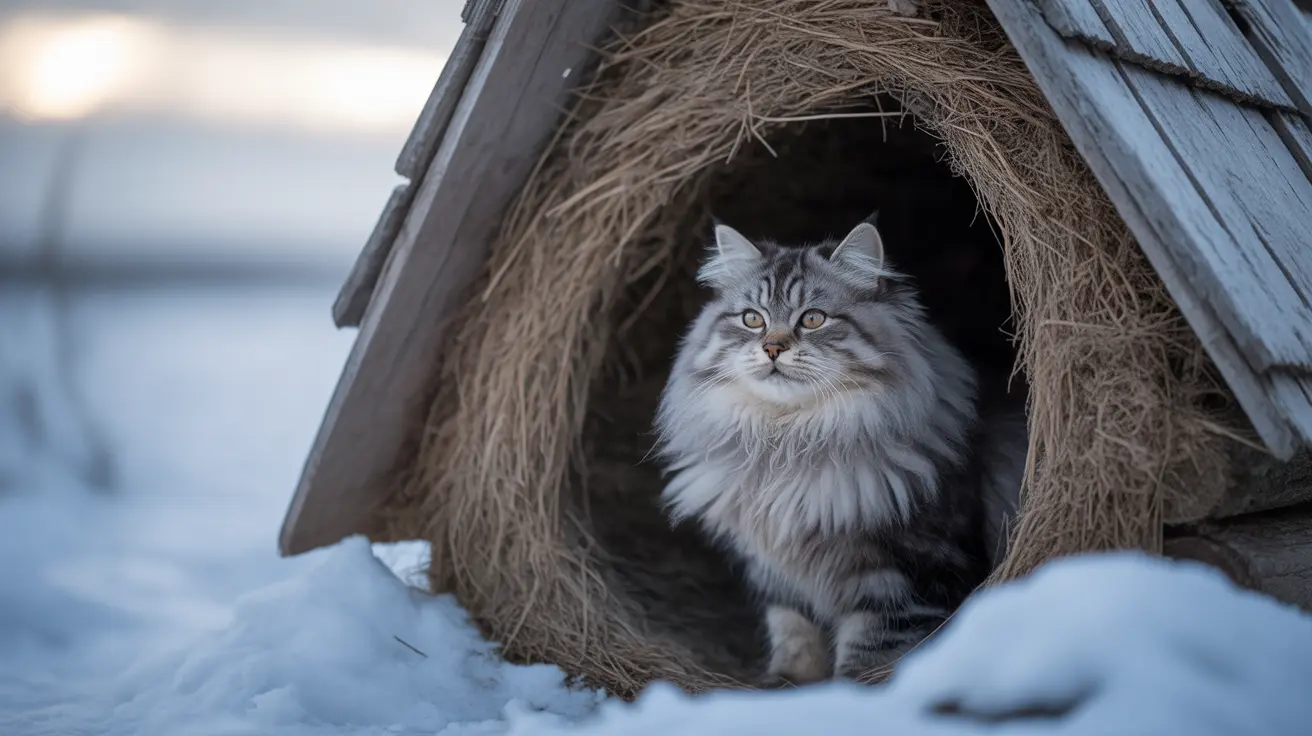How to Help Stray Cats in Winter: Essential Guide for Protecting Outdoor Cats During Cold Weather
When winter temperatures drop, millions of stray cats across the country face life-threatening challenges. These resilient animals may be well-adapted to outdoor living, but harsh winter conditions can push them to their limits. Understanding how to help stray cats in winter can mean the difference between life and death for these vulnerable animals.
Community cats, including feral and stray cats, are remarkably resourceful survivors who know where to find food and shelter in their territories. However, winter brings unique obstacles: frozen water sources, scarce food supplies, and bitter cold that can lead to frostbite, hypothermia, and other serious health issues. By providing targeted support during these challenging months, you can significantly improve their chances of survival while respecting their natural behaviors and independence.
This comprehensive guide will walk you through proven strategies for supporting stray cats during winter, from building effective shelters and establishing feeding stations to understanding when intervention is necessary. Whether you're new to helping community cats or looking to improve your current efforts, these evidence-based approaches will help you make a meaningful difference in the lives of outdoor cats in your area.
Understanding Stray Cats and Their Winter Challenges
Before diving into specific helping strategies, it's crucial to understand what stray cats face during winter months. Community cats, which include both feral cats born outdoors and former pets who have been abandoned or lost, must navigate multiple survival challenges when temperatures plummet.
The primary winter threats to stray cats include exposure to freezing temperatures, limited access to fresh water due to ice formation, reduced food availability, and increased energy demands for maintaining body heat. These cats often seek shelter in unsafe locations like car engines, storage areas, or makeshift hideouts that provide minimal protection from the elements.
Identifying whether a cat is truly stray versus an owned outdoor cat or lost pet requires careful observation. Stray cats typically appear thin, have matted or dirty fur, may show signs of injury or illness, and exhibit wariness around humans. In contrast, owned outdoor cats usually appear well-fed and groomed, while lost pets may seem confused and actively seek human interaction.
Essential Food and Water Support for Winter Survival
Providing adequate nutrition becomes critical during winter months when stray cats need extra calories to maintain their body temperature. Cats require increased food portions in cold weather to conserve energy and stay warm, making regular feeding one of the most impactful ways to support them.
When feeding stray cats during winter, focus primarily on dry food, which doesn't freeze as quickly as wet food. While wet food requires less energy for cats to digest, it can freeze solid within minutes in freezing temperatures, making it inaccessible. If you choose to provide wet food, serve it in plastic containers rather than metal ones, and provide fresh portions daily or twice daily.
Water access becomes particularly challenging when natural sources freeze. Prevent water from freezing by using several effective strategies: place water bowls in sunny locations using deep containers that retain heat longer, warm water before serving, or invest in heated electric bowls designed for outdoor use. You can also create DIY solutions by placing microwavable heating pads under water bowls or using insulation techniques like spraying foam under plastic dishes.
Building a feeding station provides essential protection for both the food and the cats themselves. An insulated feeding station functions similarly to a cat shelter, shielding food and water from wind, snow, and precipitation while creating a safer environment for cats to eat without feeling exposed to predators.
Building DIY Insulated Shelters Step-by-Step
Constructing proper winter shelters represents one of the most valuable contributions you can make to stray cats' survival. While cats are capable of finding their own shelter, additional protection significantly improves their comfort and safety during extreme weather conditions.
The ideal cat shelter should measure approximately two feet by three feet with a minimum height of 18 inches. This size accommodates three to five cats or can be smaller for fewer occupants. The entrance should be just large enough for cats to enter—typically 6-8 inches in diameter—which helps retain heat while preventing larger predators from gaining access.
Use straw as your primary insulation material, as it repels moisture and provides excellent insulation properties. Never use hay, blankets, or towels, which absorb moisture and become cold when wet, potentially creating dangerous conditions. Mylar blankets can be placed under straw to reflect body heat back to the cats.
Position shelters strategically by elevating them several inches off the ground to prevent rain and snow infiltration. Face the entrance away from prevailing winds, and when possible, position the shelter against a wall or structure that allows only cats to access it. This placement reduces heat loss and provides additional security.
Regular maintenance is essential for shelter effectiveness. Check structures regularly for damage, ensure snow doesn't block entrances, and refresh straw insulation as needed. If cats initially avoid the shelter, make it more appealing by adding small amounts of catnip, silver vine, or treats to encourage exploration.
Winter Feeding Best Practices and Safety Considerations
Successful winter feeding programs require careful planning and consistent execution. Prepare in advance for severe weather by maintaining adequate food and water supplies that can last through extended storms or periods when you cannot access feeding locations.
Establish regular feeding schedules, ideally providing food twice daily when possible. This consistency helps cats conserve energy by reducing the time spent searching for food. Clear snow from feeding areas and shelter entrances promptly to ensure cats can access these resources when needed most.
Consider the placement of feeding stations carefully to minimize conflicts with wildlife and neighbors. Choose locations that provide some natural protection from wind and precipitation while remaining accessible during severe weather. Avoid areas where food might attract unwanted animals like raccoons or bears, which can create safety issues for both cats and humans.
Critical Safety Precautions for Cold Weather
Protecting stray cats requires awareness of common winter hazards that can prove fatal. Before starting your vehicle, especially during extremely cold weather, check under the hood and around tires where cats often seek warmth. Bang on the hood or honk your horn briefly to alert any cats that might be hiding.
Avoid using antifreeze, road salt, or chemical deicers in areas accessible to cats, as these substances are highly toxic if ingested. Instead, use pet-safe deicers or provide sand and gravel for traction. Even small amounts of antifreeze can be lethal to cats, making prevention crucial.
Monitor cats for signs of hypothermia, frostbite, or cold-related injuries. Symptoms include lethargy, difficulty walking, pale or blue-tinged gums, and visible shivering. If you observe a cat showing these signs, contact a veterinarian immediately for guidance on appropriate intervention.
Trap-Neuter-Return Programs During Winter
Implementing trap-neuter-return (TNR) programs during winter months requires special considerations but remains an essential component of long-term stray cat welfare. Spaying and neutering improves cats' overall health and better equips them to withstand cold temperatures by reducing the physical stress of reproduction.
When conducting TNR during cold weather, trap cats during warmer daylight hours when possible and check traps frequently to prevent prolonged exposure to freezing temperatures. Coordinate with veterinarians who understand the unique needs of community cats and can minimize shaved areas during surgery to help cats maintain their natural fur insulation.
Ensure cats recovering from surgery are kept in temperature-controlled environments during the critical recovery period. This temporary indoor housing protects healing incisions from cold exposure and reduces the risk of post-surgical complications.
Community Engagement and Long-Term Solutions
Creating sustainable support systems for stray cats requires community involvement and coordination with local animal welfare organizations. Engage neighbors who share concerns about outdoor cats by organizing informal networks to share responsibilities for feeding and shelter maintenance.
Partner with established animal welfare groups that can provide resources, expertise, and assistance with TNR programs. Many organizations offer guidance on best practices, financial assistance for veterinary care, and connections to other community members working toward similar goals.
Consider the legal aspects of feeding and sheltering stray cats in your area, as regulations vary by location. Some municipalities have specific ordinances regarding outdoor cat care, while others may have resources available to support community cat programs.
When to Bring Cats Indoors
While most community cats are best served by remaining outdoors with support, certain situations may warrant temporary indoor shelter. If you encounter a friendly, social cat during freezing weather, it may be a lost pet or former house cat that lacks the survival skills of feral cats.
Social cats that approach humans readily and seem comfortable with handling may benefit from indoor shelter during the most severe weather conditions. However, always attempt to identify the owner first by checking for microchips, posting found pet notices, and alerting local animal shelters about your discovery.
Avoid bringing cats to traditional animal shelters unless they are ill or injured, as many facilities lack humane policies for community cats and may resort to euthanasia. Instead, contact local rescue organizations or no-kill shelters that specialize in finding homes for socialized cats.
Frequently Asked Questions
How cold is too cold for stray cats to survive outdoors?
Stray cats can survive surprisingly low temperatures, often enduring weather well below freezing. However, their survival depends on access to adequate shelter, food, and water. Temperatures below 15°F (-9°C) become increasingly dangerous, especially for young, elderly, or sick cats. With proper support including insulated shelters and regular feeding, most healthy adult cats can survive much colder conditions.
What type of shelter material works best for winter cat shelters?
Straw is the ideal insulation material for outdoor cat shelters because it repels moisture and provides excellent insulation properties. Avoid hay, blankets, towels, or other fabric materials that absorb moisture and become cold when wet. Mylar blankets can be used under straw to reflect body heat, and the shelter itself should be constructed from insulating materials like plastic storage bins or Styrofoam containers.
Should I provide heated water bowls for stray cats?
Heated water bowls designed for outdoor use can be extremely beneficial for stray cats during winter. These bowls prevent water from freezing and ensure cats have constant access to fresh water. If heated bowls aren't available, you can use alternative methods like placing bowls in sunny locations, warming water before serving, or using DIY heating solutions with microwavable heating pads placed under water containers.
How often should I feed stray cats during winter?
Feed stray cats twice daily during winter months when possible, providing increased portions to help them maintain body heat. Consistent feeding schedules help cats conserve energy by reducing time spent searching for food. Focus primarily on dry food, which doesn't freeze as quickly as wet food, and ensure you can maintain regular feeding even during severe weather conditions.
Is it safe to trap stray cats for spaying/neutering during winter?
TNR can be conducted safely during winter with proper precautions. Trap during warmer daylight hours, check traps frequently to prevent prolonged cold exposure, and ensure cats have access to temperature-controlled recovery environments after surgery. Coordinate with veterinarians experienced in community cat care who can minimize shaved areas to help cats maintain natural insulation.
What should I do if I find a friendly stray cat during winter?
A friendly, social cat may be a lost pet rather than a true feral cat. First, attempt to locate the owner by checking for identification, posting found pet notices, and contacting local shelters. If no owner is found and the cat seems comfortable with humans, consider temporary indoor shelter during extreme weather, especially if the cat appears unprepared for outdoor survival.
How can I tell if a stray cat is suffering from hypothermia or frostbite?
Signs of hypothermia in cats include lethargy, difficulty walking, shallow breathing, and pale or blue-tinged gums. Frostbite typically affects ears, tail, and paws, causing discoloration and potential tissue damage. If you observe these symptoms, contact a veterinarian immediately. Prevention through adequate shelter, regular feeding, and safety precautions is far more effective than treating cold-related injuries after they occur.
Conclusion
Learning how to help stray cats in winter empowers you to make a life-saving difference for vulnerable animals in your community. Through consistent food and water provision, well-constructed shelters, and appropriate safety precautions, you can significantly improve stray cats' chances of surviving harsh winter conditions. Remember that these resilient animals are remarkably adapted to outdoor living, but your thoughtful support can mean the difference between mere survival and thriving through the coldest months.
The most effective approach combines immediate winter relief with long-term solutions like TNR programs and community engagement. By working with local animal welfare organizations and building networks of concerned neighbors, you can create sustainable support systems that benefit stray cats year-round. Every cat deserves compassion and care, and your efforts to help stray cats navigate winter challenges reflect the best of human kindness toward animals who have no other advocate than caring people like you.






